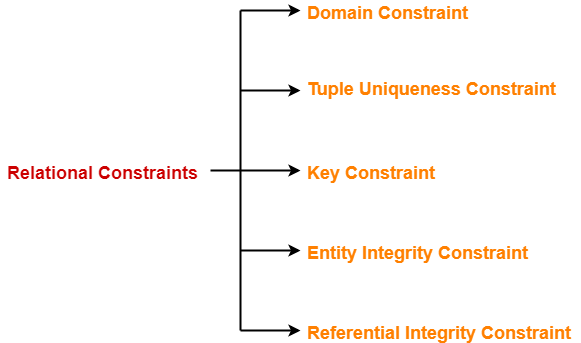Explain Different Types of Constraints in Sql
The NOT NULL constraint prevents a column from having a NULL value. Types of Data Constraints.
The following are some types of constraints.

. These constraints are applied only to the single column that limits the type of particular column data. Constraints that are applied in the data model is called Implicit constraints. A unique constraint also referred to as a unique key constraint is a rule that forbids duplicate values in one or more columns within a table.
Types of Constraints in MySQL with Examples 1. The table contains a CHECK CONSTRAINT on commission columnThe constraint ensures that the. This constraint limits the values that can be entered in that particular column of the table.
Constraints in MySQL is classified into two types. Oracle Constraints clause provides data integrity to the data that is being used by the application from the database by applying certain rules or conditions on a column of a database table which will define a very basic behavioral layer on the column of that particular table to check the sanctity of the data flowing into it like NOT NULL constraint on the column will not allow any data of. See the answer See the answer done loading.
The UNIQUE constraint uniquely identifies each record in a database table. The SQL CHECK CONSTRAINT can not be used on a VIEW. And we can see how they are defined using the Vertabelo Data.
Explain the different types of entity constraints with examples. Different SQL Constraints and Usage. When no value is defined for a column the DEFAULT Constraint provides a default value.
In DBMS there are following 5 different types of relational constraints. A NOT NULL constraint is a rule that prevents null values from being entered into one or more columns within a table. FOREIGN KEY Constraint in SQL.
Informational constraints are not enforced by the database. Constraints can be divided into the following two types Column level constraints. We use input and output constraints to check the speed of insertion extraction and deletion.
The UNIQUE and PRIMARY KEY constraints both provide a guarantee for uniqueness for a column or set of columns. We need to issue the following two statements in SQL Server to create these constraints. A PRIMARY KEY constraint automatically has a.
There are five types of constraints. ALTER TABLE Product ADD CONSTRAINT DF_Product_EntryDate DEFAULT GETDATE FOR EntryDate. Types of MySQL Constraints.
But to create this connection you need to pass a command which is. The following constraints are commonly used in SQL. We review their content and use your feedback to keep the quality high.
Uniquely identifies each row in a table FOREIGN KEY - Prevents actions that. When CHECK constraint is applied to a column it ensures that the column will not accept data. Column level constraints apply to specific columns in a table and do not specify a column name except the check constraints.
The SQL CHECK CONSTRAINT can not be used in a subquery. ALTER TABLE Product ADD CONSTRAINT DF_Product_CurrentStock DEFAULT 0 FOR CurrentStock. NOT NULL - Ensures that a column cannot have a NULL value UNIQUE - Ensures that all values in a column are different PRIMARY KEY - A combination of a NOT NULL and UNIQUE.
Unique and primary keys are the supported unique constraints. Each rowrecord in a database table is uniquely identified by the PRIMARY Key. Informational constraints An informational constraint is a constraint attribute that can be used by the SQL compiler to improve the access to data.
This constraint is used when you do not want any value in that particular column to be a Null. Who are the experts. A UNIQUE Constraint ensures that any value in a column is unique.
They refer to the column that they follow. It handles foreign affairs by connecting to the PRIMARY KEY values of another table. When NOT NULL constraint is applied to a column it ensures that the column will not accept NULL.
The names are specified by the Table-level constraints of the columns to which they apply. Primary Key Foreign Key etc. SQL constraints can be at a column or a table level.
Types of SQL Constraints. Different Kinds of SQL Constraints 1. Constraints in the databases can be categorized into 3 main categories.
Experts are tested by Chegg as specialists in their subject area. Foreign key constraints also known as referential constraints or referential integrity constraints enable definition of required relationships between and within tables. These are called as schema-based constraints or Explicit constraints.
The FOREIGN KEY constraint in SQL is usually used to build relationships between tables in a database. Constraints that are directly applied in the schemas of the data model by specifying them in the DDLData Definition Language. SQL Constraints are rules used to limit the type of data that can go into a table to maintain the accuracy and integrity of the data inside table.
These are applicable on the data before the data is tucked in the table. The following example creates a table. These constraints are applied to the entire table that limits the type of data for the whole table.
The SQL CHECK CONSTRAINT can also be used in ALTER TABLE and DROP TABLE statement.

Constraints In Dbms Types Of Constraints In Dbms Gate Vidyalay

Constraints In Sql Server Sql Not Null Unique And Sql Primary Key

Constraints In Sql Server Sql Not Null Unique And Sql Primary Key


No comments for "Explain Different Types of Constraints in Sql"
Post a Comment